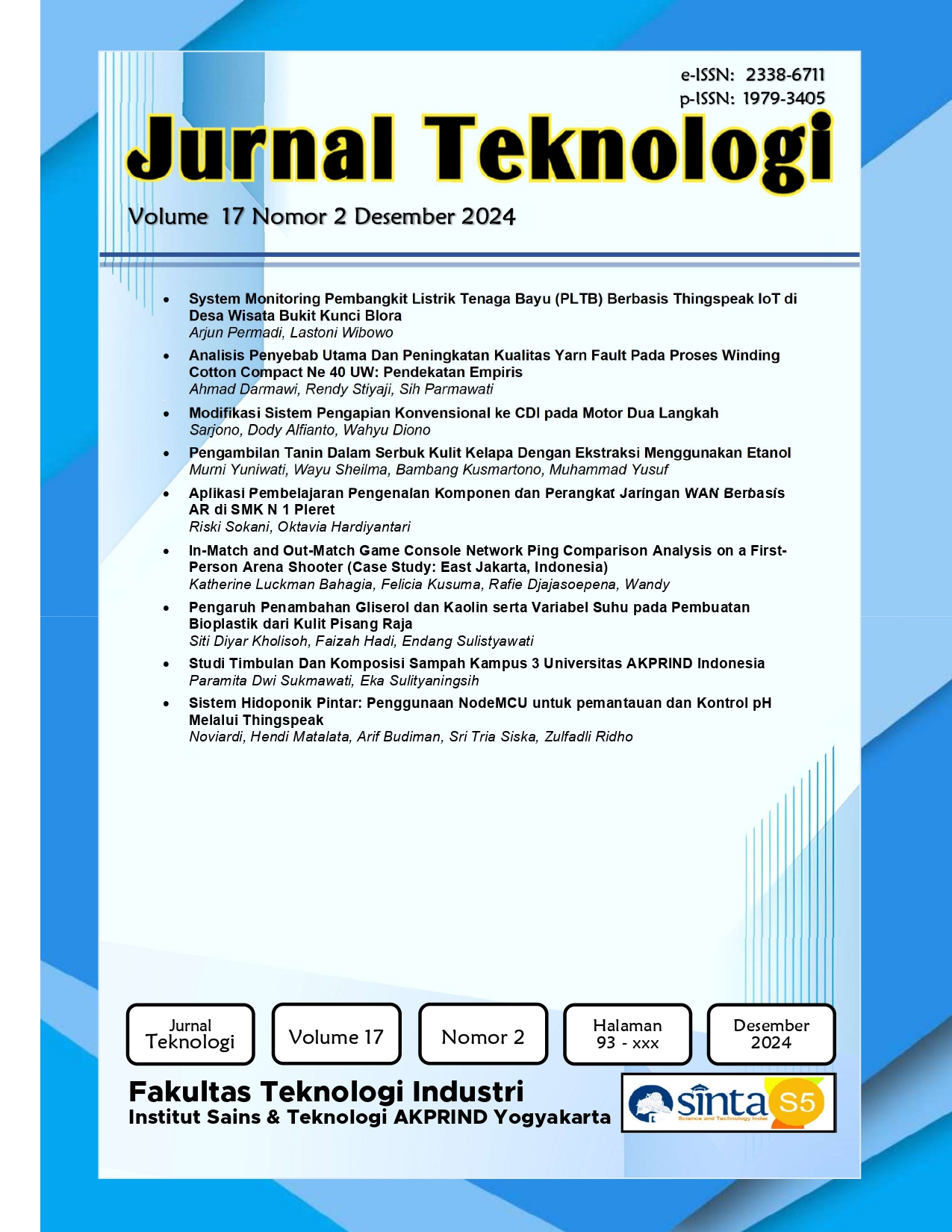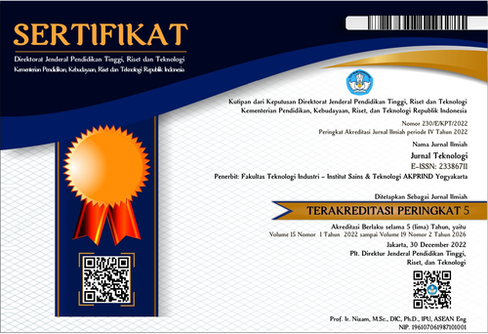Sistem Hidoponik Pintar : Penggunaan NodeMCU untuk pemantauan dan Kontrol pH Melalui ThingsSpeak
DOI:
https://doi.org/10.34151/jurtek.v17i2.4368Keywords:
hydroponics, kale, pH, thingspeakAbstract
OThis study focuses on the development of a water pH control device for hydroponic systems, specifically in the measurement and regulation of water pH in hydroponics. The design of the water pH control device utilizes a NodeMCU module and the Thingspeak platform based on the Internet of Things (IoT). The purpose of this research is to design, develop, and implement a water pH control tool for hydroponic water spinach cultivation, capable of accurately monitoring and measuring water pH within the hydroponic system. The performance of the IoT-based water pH control device in this study aims to enhance the efficiency of plant growth environment management, productivity, and harvest quality in hydroponic farming of water spinach
Downloads
References
Alam, A. S., & Matalata, H. (2018). Perancangan Alat Pengolahan Air Minum Otomatis Pada Proses NetralisasI Ph dan aerasi. Journal of Electrical Power Control and Automation (JEPCA), 1(2), 33. https://doi.org/10.33087/jepca.v1i2.8
Alfia, R., Widodo, A., Kholis, N., & Nurhayati. (2021). Sistem Monitoring Kualitas Air Pada Sistem Akuaponik Berbasis Iot. Jurnal Teknik Elektro, 10(3), 707–714.
Arief, R., Hardianto, H., & Muliawan, A. (2020). Rancang Bangun pH Meter Otomatis menggunakan ATMega 16 dalam Upaya Peningkatan Akurasi Pembacaan pH Larutan Senyawa Kimia. Emitor: Jurnal Teknik Elektro, 20(1), 62–69. https://doi.org/10.23917/emitor.v20i1.8799
Mufida, E., Anwar, R. S., Khodir, R. A., & Rosmawati, I. P. (2020). Perancangan Alat Pengontrol pH Air untuk Tanaman Hidroponik Berbasis Arduino Uno. Jurnal Inovasi, 1(1), 13–19.
Prasetiyo, E. E., & Ma’ruf, F. (2018). Prototipe Sistem Pemantauan dan Pengendalian Beban Listrik Berbasis Internet of Things (IoT) dengan Aplikasi Cayenne. Jurnal Teknologi, 11(1), 23–30. http://www.1to1media.com/data-
Pratiwi Baharsyah, A., & Iqbal Suriansyah, M. (2024). Sistem Penunjang Keputusan Normalisasi Ph Dan Tds Pada Vertical Garden Tanaman Kangkung Dengan Menggunakan Fuzzy Logic Mamdani Berbasis Internet Of Things. DIKE : Jurnal Ilmu Multidisiplin, 2(1), 9–16. https://doi.org/10.69688/dike.v2i1.63
Putri, R. E., Habib, A., & Hasan, A. (2023). Rancang Bangun Sistem Kontrol Ph Larutan Nutrisi dan Pencahayaan Berbasis Internet of Things (IOT) PADA HIDROPONIK VERTIKULTUR. Jurnal Teknologi Pertanian, 12(1), 41–50. https://doi.org/10.32520/jtp.v12i1.2551
Rahman, A. T., & Herlina, A. (2022). Rancang Bangun Sistem Monitring Dan Kontrol Pencampuran Nutrisi Dan Ph Air Pada Tanaman Hdiroponik Berbasis Internet Of Things. JEECOM Journal of Electrical Engineering and Computer, 4(2), 87–95. https://doi.org/10.33650/jeecom.v4i2.4460
Setiadi, I. (2019). Pengaman Laju Air Umpan Untuk Arsinum Kapasitas 5M3/Hari Menggunakan Pressure Switch Dan Selenoid Valve. Jurnal Rekayasa Lingkungan, 11(2), 75–83. https://doi.org/10.29122/jrl.v11i2.3442
Simanjuntak, M. N., Andromeda, T., & Soetrisno, Y. A. A. (2020). Perancangan Sistem Monitoring Dan Kendali Derajat Keasaman Pada Tanaman Hidroponik Sistem Nutrient Film Technique (Nft) Menggunakan Metode Kontrol Pid. Transient: Jurnal Ilmiah Teknik Elektro, 9(4), 556–563. https://doi.org/10.14710/transient.v9i4.556-563
Wati, D. R., & Sholihah, W. (2021). Pengontrol pH dan Nutrisi Tanaman Selada pada Hidroponik Sistem NFT Berbasis Arduino. Multinetics, 7(1), 12–20.
Downloads
Published
How to Cite
Issue
Section
License
Copyright (c) 2024 Hendi Matalata

This work is licensed under a Creative Commons Attribution-ShareAlike 4.0 International License.
Jurnal Teknologi provides immediate open access to its content in order of making research freely available to the public to support a global exchange of knowledge. All articles published in this journal are free for everyone to read and download, under licence CC BY SA.
Benefits of open access for the author, include:
- Free access for all users worldwide.
- Authors retain copyright to their work.
- Increased visibility and readership.
- No spatial constraints.




















